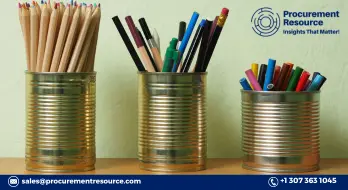High Electronics Demand and Delivery Concerns Leads to Surge in Tin Prices

Because of tin scarcity, there has been an increase in demand for consumer electronics and difficulties in moving metal out of Asia, pushing metal prices to unthinkable heights for the first time in history. Tin for three months' supply has risen 46 percent this year on the London Metal Exchange to USD 29,785 per metric tonne, outperforming other metals such as copper and aluminium. Tin last traded for that much at the height of the metal market bubble in 2011, when prices exceeded USD 33,000 per tonne.
In the last year, tin's increase is one of the significant changes in commodity markets, raising investor expectations that inflation will go up, at least temporarily. Increasing commodity prices have hampered industrial output, and organisations seek to pass on higher input costs to consumers, who are already feeling the strain. Concerns over inflation have prompted anxieties on Wall Street, leading to stocks declining.
Demand is out of hand, Evan Morris, co-president of Nathan Trotter & Co., stated, stressing that he has never seen severe tin shortfalls. The manufacturer of solder wire and other tin products in Sadsburyville, Pa., is struggling to keep up with the growth. The coronavirus has hindered raw metal supplies in Indonesia and elsewhere.
In contrast, congestion in container-shipping markets has caused weeks-long delays in tin transportation from Southeast Asia and Latin America. Due to the drop in semiconductor demand, tin became the most expensive primary base metal in 2019.
Lockdowns and factory closures hampered sales of commodities in early 2020, with producers and exporters considerably down. After a year, the market is probably the most pressured it's ever been, according to Charles Swindon, managing director of RJH Trading Ltd. based in the United Kingdom.
There are just not enough supplies as the week before, only 490 tonnes of refined tin were available in London Metal Exchange warehouses worldwide, with 840 tonnes more on the way out. This is only over half of what was anticipated at the end of 2020 is now accessible.
Metal in LME sheds is regarded as a source of last resort, according to Tom Mulqueen, an analyst at Amalgamated Metal Trading Ltd., so withdrawals suggest shortages on the broader market. Cornish Metals Inc., a burgeoning tin miner, benefits from the uptick.
Last month, the company used a diamond-coated drill to make a hole into the earth in Cornwall's Gwennap district, where copper was mined in the 17th and 18th centuries in search of copper and tin. Chief Executive Richard Williams stated, that to fund the exploration, Cornish Metals is listed itself on the stock exchange and raised 8.2 million pounds a deal that attained the pull due to the upswing in prices.
The rise in metal prices has bolstered mining company stock values. The iShares MSCI Global Metals & Mining Producers exchange-traded fund from BlackRock Inc. has increased 34% this year. During the pandemic, consumer electronics like laptops, mobile phones, and televisions saw a surge in sales, contributing to the recovery.
According to the Semiconductor Sector Association, a trade group for the semiconductor industry in the United States, global manufacturing revenue increased 3.6 percent in the first three months of 2021 compared to the same period last year and 17.8 percent year on year.
Another reason for the scarcity of refined tin in the West is the months-long lack of freight containers. Traders are facing delays and hikes in prices while transporting the fine metal from Malaysia, Indonesia, and Thailand, the three largest suppliers, to consumers outside of China. As per the freight-booking platform Freightos, the expense of a 40-foot container moving goods from Asia to the West Coast reached USD 5,144 on Friday, which is more than three times at the start of 2020.



